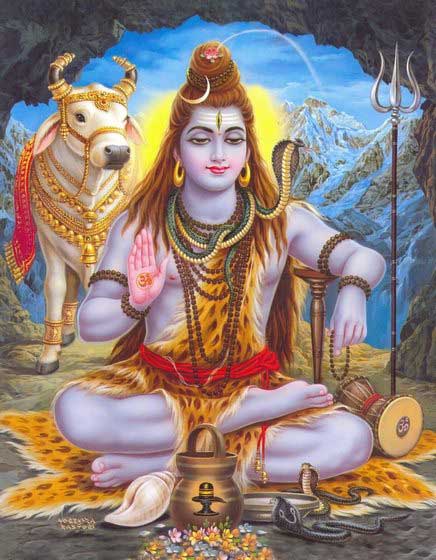How Lord Shiva Manifest In This World
The
previous paragraphs point out how Lord Shiva participated in the creation
process as Shambhu, and it is also related how Lord Shiva appeared
in this world in a personal form from Lord Brahma. It is explained in the Bhagavatam
(3.12.4), that in the beginning of the creation process, Lord Brahma manifested
four great sages named Sanaka, Sananda, Sanatana and Sanat-kumara. Brahma
expected them to assist in filling the universe with varieties of living beings.
However, they were unwilling to adopt materialistic activities because they were
highly elevated beings. Brahma requested that they begin to produce progeny, but
they refused because they were already attached to Lord Vasudeva, the Supreme
Lord, and were focused on achieving liberation. So they expressed their
unwillingness, which made Lord Brahma extremely angry.
The
anger generated in the mind of Lord Brahma, though he tried to control it, came
out from between his eyebrows. Immediately there was produced a child of mixed
red and blue color. This child immediately began to cry and requested to Lord
Brahma, “O destiny maker, teacher of the universe, kindly designate my name
and place.” Lord Brahma then pacified the boy and said, “O chief of the
demigods, you shall be called Rudra because you have cried so anxiously.” Then
Brahma gave Rudra the following places for his residence: the heart, the senses,
the life-air of the body, the sky, the air, the fire, water, earth, sun, the
moon and austerity. He then told Rudra that he would be known by eleven
other names: Manyu, Manu, Mahan, Shiva, Ritadhvaja, Ugrareta, Bhava, Kala,
Vamadeva and Dhritavrata. These names represent the other aspects of Lord Shiva,
each having different appearances and activities. Rudra is often shown as tall,
well built, with long hair, wielding the thunderbolt, bow and arrow. He is
viewed as the protector of humanity against its enemies. He is also known as an
excellent physician and has numerous medicines which can cure diseases. Brahma
also told Rudra that he would have eleven wives, namely Dhi, Dhriti, Rasala, Uma,
Niyut, Sarpi, Ila, Ambika, Iravati, Svadha and Diksha.
Brahma
then told Rudra to accept these names and wives, and that since he was one of
the masters of the living beings, he should now increase the population on a
large scale. Rudra then created many offspring that resembled him in color,
strength, and furious nature. They were unlimited in number, and when they
gathered together, they attempted to devour the universe. Brahma, becoming
alarmed at the situation, then requested Rudra not to generate living beings of
this nature. It would be better if Rudra engaged himself in penance, or
meditation, which is auspicious for all. Through penance he could create the
universe as it was before. By penance only can one approach the Supreme Lord,
who is within the heart of every living being and at the same time beyond the
reach of the senses. Thus Rudra accepted the advice of his father, Brahma, and
went to the forest to perform austere penances. This is why we so often see
Shiva pictured in the mountain forests engaged in meditation.
Some
of Shiva’s other names include
Dakshinamurti, meaning a universal teacher. Then there is Trilochana
(Three-eyed), Nila-kantha (Blue-throated), Pancha-anana (Five-faced),
Chandrashekhara (Moon-crested), Gangadhara (Bearer of the Ganga), Girisha
(Mountain Lord), Jatadhara (Wearer of matted hair), Sthanu (Immutable),
Visvanatha (Lord of the Universe), Bhairava (the Terrible, destructive aspect of
Shiva), Bhutesha or Bhuteshvara (Lord of ghosts or elements), Hara (remover of
death), Shambhu (abode of joy), Shankara (giver of joy), Bhava (existence),
Mahadeva (great God), Ashani (thunderbolt), Isha or Ishana (the ruler),
Pashupati (the herdsman or friend of animals), Mritunjaya (conqueror of death),
Aghora (non-fearful), Ugra (the fearful), Bhima (the tremendous), Rudra (Lord of
tears), Shuli, Maheshvara, Ishvara, Sharva, Khandaparashu, Mrida, Krittivasas,
Pinaki, Pramathadhipa, Kapardi, Shrikantha, Shitikantha, Kapalabhrit, Vamadeva,
Mahadeva, Virupaksha, Krishanuretas, Sarvajna, Dhurjati, Nilalohita, Smarahara,
Bharga, Tryambaka, Tripurantaka, Antakaripu, Kratudhvamsi, Vrishadhvaja,
Vyomakesha, Umapati, Ahirbudhnya, Ashtamurti, Gajari, Mahanata, and others. The
1000 names of Shiva can be found in Chapter 17 of the Anushasana Parva of the Mahabharata,
as well as the Linga Purana (1.65-98).


No comments:
Post a Comment